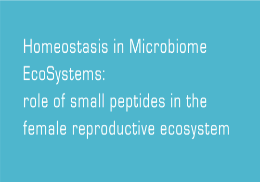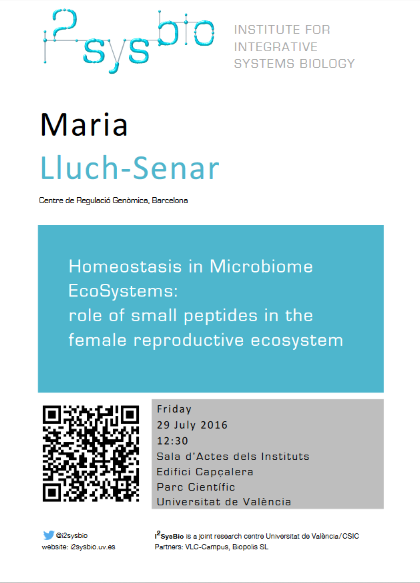
MARIA LLUCH-SENAR.
Date: 29 July 2016.
Hour: 12:30.
Venue: Sala d’Actes dels Instituts (Edifici de Capçalera, Parc Científic, Universitat de València).
Organizer: Institute for Integrative Systems Biology I2SysBio (UV-CSIC)
Host: Marta Tortajada (marta.tortajada@biopolis.es).
Small open reading frames (smORFs), which encode for proteins of less than 100 amino acids, is an emerging area of systems biology. smORFs are widely distributed throughout nature, including bacteria, animals, and plants, and have been shown to perform a variety of functions. smORFs in bacteria have been shown to be involved in stress responses, regulate virulence, sporulation as well as, quorum sensing. Indeed, antimicrobial peptides (AMPs) are also expressed and secreted by insects, animals, plants and humans. Thus, bacteria can produce small peptides as virulence factors and eukaryotes can produce AMPs to fight against bacterial infections. The question that arises is how in human ecosystems, bacteria and epithelial interfaces are in a well‐balanced homeostasis and how these small peptides could be involved in it. Epithelial interfaces are constantly confronted with an immensely complex ecology of microorganisms (microbiome). Despite specific bacteria are mutualistic inhabitants, their population needs to be tightly controlled to ensure it stays benevolent rather than taking advantage of a debilitated host. Losses in the homeostasis lead to diseases like bacterial vaginosis (BV) in female reproductive tract (FRT). Herein, the main goal of our project is the identification of small peptides in the vaginal ecosystem to understand their role in FRT ecosystem homeostasis and ultimately to modulate and restore it to a healthy status in patients with BV.
About
Maria Lluch-Senar. CRG, PRBB, Barcelona
Maria Lluch-Senar graduated in Biotechnology (UAB) in 2004 and received a PhD on Biotechnology at IBB (Institut de Biotecnologia i Biomedicina, UAB). She developed further research at University of Görg (Göttingen) in 2007, and at the Luis Serrano’s Biological Systems Design Lab in 2013 (CRG, PRBB). Currently is a Staff Scientist in this lab.
Images:













